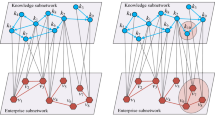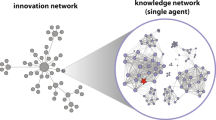Abstract
Based on the evolutionary algorithms of the four complex networks, the evolution of knowledge network is regarded as that of complex networks. With the heterogeneity of knowledge level, knowledge absorptive and innovative capacity and agents’ knowledge types considered, theoretical models of knowledge network evolution are constructed. Through numerical simulation, different network structures are analyzed in terms of their effects on the diffusion efficiency of the overall knowledge as well as of various types of knowledge. The simulation results show that: with the diffusion of the overall knowledge considered, although the overall knowledge level in a small-world structure is lower than the random network in the early and middle stage, it is close to the highest one later on; moreover, its growth rate is relatively higher among all four networks and its knowledge levels are distributed most uniformly. With regard to the diffusion of different types of knowledge, the small-world network is proved to produce the most uniform gap between knowledge types and help those dominant industries in the early stage remain advanced during the evolutionary process.






Similar content being viewed by others
References
Wei, Q., Gu, X.: Knowledge networks formation and interchain coupling of knowledge chains. J. Appl. Sci. 13(20), 4181–4187 (2013)
Goldenberg, A., Zheng, A.X., Fienberg, S.E., Airoldi, E.M.: A survey of statistical network models. Found. Trends Mach. Learn. 2(2), 129–233 (2010)
Raducha, T., Gubiec, T.: Coevolving complex networks in the model of social interactions. Phys. A 471, 427–435 (2017)
Luo, S., Du, Y., Liu, P., Xuan, Z., Wang, Y.: A study on coevolutionary dynamics of knowledge diffusion and social network structure. Expert Syst. Appl. 42(7), 3619–3633 (2015)
Luo, S., Du, Y., Liu, P., Xuan, Z., Wang, Y.: A study on coevolutionary dynamics of knowledge diffusion and social network structure. Expert Syst. Appl. 42(7), 3619–3633 (2015)
Long, W., Guan, L., Shen, J., Song, L., Cui, L.: A complex network for studying the transmission mechanisms in stock market. Phys. A 484, 345–357 (2017)
Li, H., An, H., Fang, W., Wang, Y., Zhong, W., Yan, L.: Global energy investment structure from the energy stock market perspective based on a heterogeneous complex network model. Appl. Energy 194, 648–657 (2017)
Li, T., Ma, J.: The complex dynamics of R&D competition models of three oligarchs with heterogeneous players. Nonlinear Dyn. 74(1–2), 45–54 (2013)
Bogliacino, F., Pianta, M.: Profits, R&D, and innovation—a model and a test. Ind. Corp. Chang 22(3), 649–678 (2012)
Lin, J., Ban, Y.: The evolving network structure of US airline system during 1990–2010. Phys. A 410, 302–312 (2014)
Jia, T., Jiang, B.: Building and analyzing the US airport network based on en-route location information. Phys. A 391(15), 4031–4042 (2012)
Pastor-Satorras, R., Vespignani, A.: Epidemic dynamics and endemic states in complex networks. Phys. Rev. E 63(6), 066117 (2001)
Barthélemy, M., Barrat, A., Pastor-Satorras, R., Vespignani, A.: Dynamical patterns of epidemic outbreaks in complex heterogeneous networks. J. Theor. Biol. 235(2), 275–288 (2005)
Beckmann, M.J.: Economic models of knowledge networks. In: Networks in Action, pp. 159–174. Springer, Berlin (1995)
Kobayashi, K. Knowledge Network and Market Structure: An Analytical Perspective. In: Networks in Action, pp. 127–158. Springer, Berlin (1995)
Chen, C., Hicks, D.: Tracing knowledge diffusion. Scientometrics 59(2), 199–211 (2004)
Luo, S., Du, Y., Liu, P., Xuan, Z., Wang, Y.: A study on coevolutionary dynamics of knowledge diffusion and social network structure. Expert Syst. Appl. 42(7), 3619–3633 (2015)
Lööf, H., Broström, A.: Does knowledge diffusion between university and industry increase innovativeness? J. Technol. Transf. 33(1), 73–90 (2008)
Cowan, R., Jonard, N.: Network structure and the diffusion of knowledge. J. Econom. Dyn. Control 28(8), 1557–1575 (2004)
Lin, M., Li, N.: Scale-free network provides an optimal pattern for knowledge transfer. Phys. A 389(3), 473–480 (2010)
Zhou, W., Jia, Y.: Predicting links based on knowledge dissemination in complex network. Phys. A 471, 561–568 (2017)
Liu, J.G., Zhou, Q., Guo, Q., Yang, Z.H., Xie, F., Han, J.T.: Knowledge diffusion of dynamical network in terms of interaction frequency. Sci. Rep. 7(1), 10755 (2017)
Wang, H., Wang, J., Ding, L., Wei, W.: Knowledge transmission model with consideration of self-learning mechanism in complex networks. Appl. Math. Comput. 304, 83–92 (2017)
Darr, E.D., Kurtzberg, T.R.: An investigation of partner similarity dimensions on knowledge transfer. Organ. Behav. Hum. Decis. Process. 82(1), 28–44 (2000)
Szulanski, G.: The process of knowledge transfer: a diachronic analysis of stickiness. Organ. Behav. Hum. Decis. Process. 82(1), 9–27 (2000)
Argote, L., Ingram, P.: Knowledge transfer: a basis for competitive advantage in firms. Organ. Behav. Hum. Decis. Process. 82(1), 150–169 (2000)
Tamer Cavusgil, S., Calantone, R.J., Zhao, Y.: Tacit knowledge transfer and firm innovation capability. J. Bus. Ind. Mark. 18(1), 6–21 (2003)
Bartol, K.M., Srivastava, A.: Encouraging knowledge sharing: the role of organizational reward systems. J. Leadersh. Organ. Studies 9(1), 64–76 (2002)
Gurteen, D.: Creating a knowledge sharing culture. Knowl. Manag. Magaz. 2(5), 1–4 (1999)
Barabási, A.L., Albert, R.: Emergence of scaling in random networks. Science 286(5439), 509–512 (1999)
Watts, D.J., Strogatz, S.H.: Collective dynamics of ‘small-world’networks. Nature 393(6684), 440–442 (1998)
Acknowledgements
This work is partially supported by grants from the National Natural Science Foundation of China (No. 71602012), Chengdu Soft Science Project (No. 2016-RK00-00247-ZF) and Philosophy and Social Science Research Fund Project of Chengdu University of Technology (No. YJ2017-JX003).
Author information
Authors and Affiliations
Corresponding author
Rights and permissions
About this article
Cite this article
Zhang, L., Wei, Q., Yuan, Y. et al. Knowledge diffusion simulation of knowledge networks: based on complex network evolutionary algorithms. Cluster Comput 22 (Suppl 6), 15255–15265 (2019). https://doi.org/10.1007/s10586-018-2559-3
Received:
Revised:
Accepted:
Published:
Issue Date:
DOI: https://doi.org/10.1007/s10586-018-2559-3




